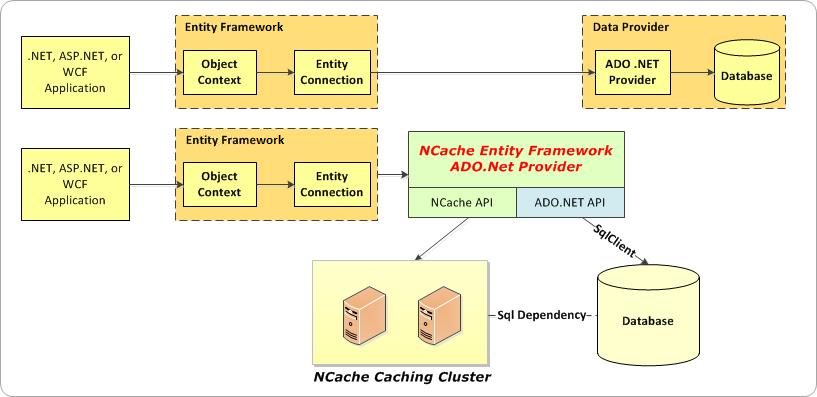Entity Framework Cache Integration [Deprecated]
Entity Framework provides abstraction from the underlying relational data stored in a database and presents its conceptual schema to the application, preventing the need to write database persistence code. It can be seen in most of the high transaction applications where scalability and performance cannot be compromised. However, in some cases, the database becomes a bottleneck as the database tier does not support adding more servers. So, to achieve scalability, NCache provides a pluggable in-memory cache provider to act as a Second-level Cache and cache the query results.
The upsides to using NCache as a Second-level Cache in Entity Framework applications are:
- Seamless Integration: The NCache Entity Framework Cache Provider can be integrated into the application without any code change.
- Better Performance: The NCache Entity Framework Cache Provider intercepts all the database query calls and caches the query result sets. This increases the performance of applications by avoiding expensive database trips.
- Application Scalability: NCache, a reliable and shared memory resource for storage, allows to sharing of transactional context between different entities in any Entity Framework application.
The caching provider can perform various functions, such as:
- Managing connections, commands, transactions, and data readers.
- Monitoring queries and commands before they execute.
The following figure shows how and where the NCache Entity Framework Provider plugs into an Entity Framework application.

Entity Framework Cache Integration Modes
There are two execution modes for the NCache Entity Framework Caching Provider:
- Analysis mode
- Caching mode
These modes are mutually exclusive, so the NCache Entity Framework Caching Provider cannot execute in both modes at the same time. It can either be in "Caching" mode or in "Analysis" mode.
Important
It is recommended to execute the Entity Framework application within the Analysis mode of the NCache Entity Framework Caching Provider to analyze which queries should be used for execution.
Analysis Mode
Analysis mode is a pass-through mode where no caching is done rather the application examines the set of queries to be used. This mode also provides the following features:
- Monitor Queries: This helps to determine the number of times a query is executed by Entity Framework application. This aids the user in filtering out the high-frequency queries for caching.
- Generate Reports: This is for queries with proper syntax and arranging them in descending order. Also allows the user to choose relevant queries and copy them for caching.
<analysis-report>
<query>
<!--Call count = 12-->
<cache-query query-text="SELECT [Extent1].[ProductID] AS [ProductID], [Extent1].[ProductName] AS [ProductName], [Extent1].[SupplierID] AS [SupplierID], [Extent1].[CategoryID] AS [CategoryID], [Extent1].[QuantityPerUnit] AS [QuantityPerUnit], [Extent1].[UnitPrice] AS [UnitPrice], [Extent1].[UnitsInStock] AS [UnitsInStock], [Extent1].[UnitsOnOrder] AS [UnitsOnOrder], [Extent1].[ReorderLevel] AS [ReorderLevel], [Extent1].[Discontinued] AS [Discontinued] FROM [dbo].[Products] AS [Extent1] WHERE 5 = [Extent1].[ProductID]"/>
<cache-policy vary-by-cache-param="" expiration-type="Absolute" enabled="True" expiration-time="30sec" dbsyncdependency="False" resyncProviderName="EFResync"/>
</query>
</analysis-report>
Caching Mode
This mode is designed for the actual use of NCache in Entity Framework applications. At this point, queries and their result sets are cached. Caching mode only entertains those queries which are given in the configuration file i.e., efcaching.ncconf.
NCache Supported Features with Entity Framework
NCache acts as a Second-level Cache for Entity Framework applications, providing the following features, which can be specified through the Entity Framework Caching config file:
Cache synchronization with database: In some cases, some data in the cache may be changed in the database without the application's involvement. Hence, you can specify the corresponding classes for the database synchronization feature of NCache. This allows NCache to connect with the database, monitor data changes, and update the cache automatically to ensure that data in the cache is always synchronized with the database. NCache provides SqlDependency for SQL Server, OracleDependency for Oracle, and DbDependency for any OLEDB-compliant databases.
Absolute Expiration: Absolute Expiration is specified separately for each cached item and is a
DateTimevalue that specifies when NCache should automatically expire the item. For Entity Framework, NCache asks you to specify an "interval" in seconds and then uses theNow + intervalformula to calculate the date-time value for Absolute Expiration.Sliding Expiration: Sliding Expiration is specified separately for each cached item and is an interval value (seconds). NCache expires the cached item if it has neither been fetched nor updated for this interval.
Compact Serialization: NCache allows you to register your Entity Framework classes for Compact Serialization and generates serialization code when your application connects to the cache. NCache dynamically compiles this code in-memory and uses it for serialization, thereby increasing the serialization performance.
In This Section
Using NCache as Entity Framework (EF) Second-level Cache
Explains how to configure and use NCache as Entity Framework Second-level cache.
Entity Framework Resync Provider
Explains the Resync mechanism of NCache and how it keeps the data up to date across the cluster.
Entity Framework (EF) Caching Configuration File
Explains the changes required in efcaching.ncconf file to run the Entity Framework application in NCache.